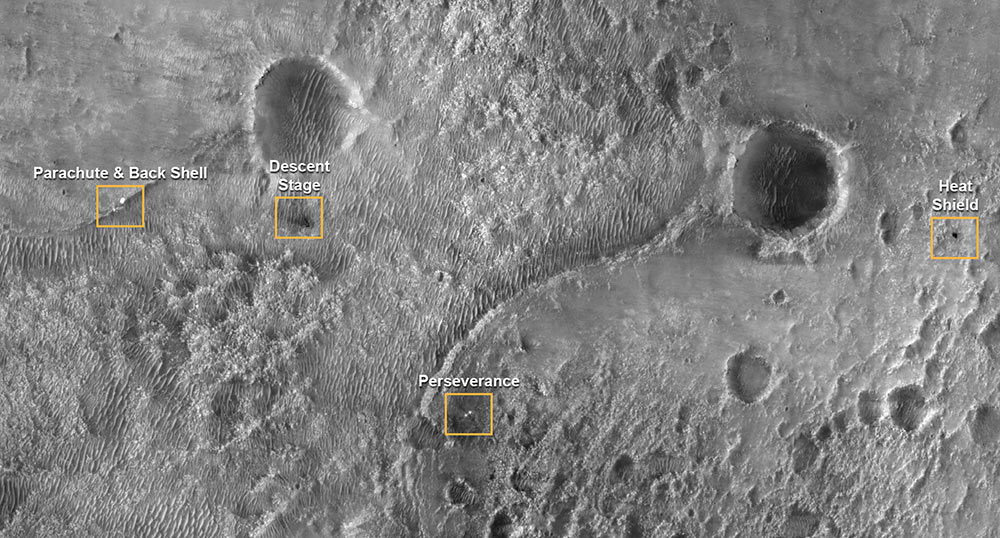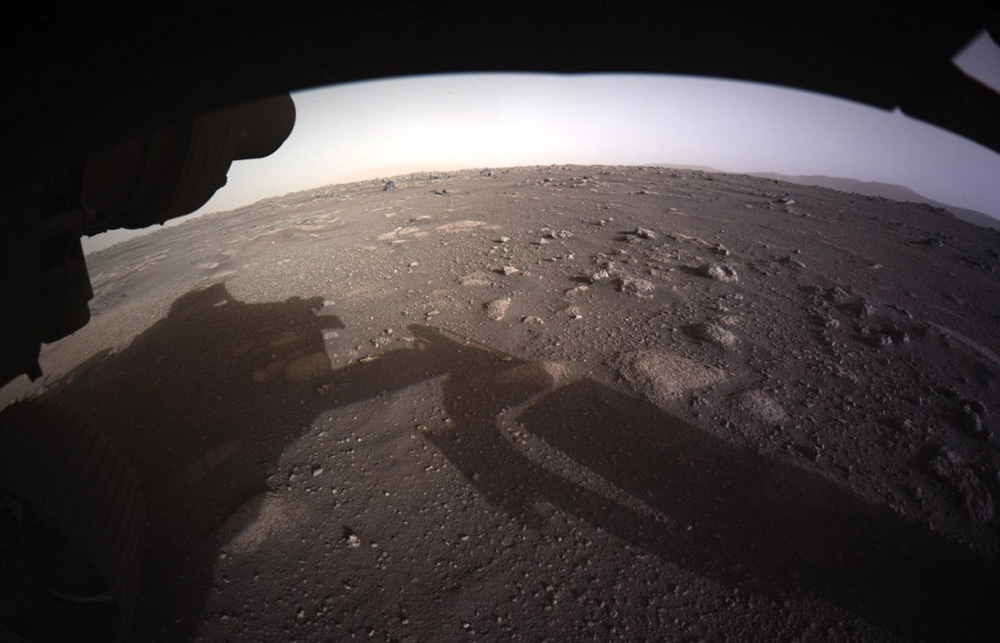登陆火星是什么感觉?
这一问题不再神秘:2月22日下午,美国国家航空航天局(NASA)发布了首支火星探测器降落到这颗红色星球上的视频片段。这段录像以及史无前例的在火星表面记录下的录音,揭示了该局最新的火星探测器“毅力号”( Perseverance)于2月18日在火星着陆时的紧张时刻。
在这段视频中,火星探测器从距离火星表面12公里处的大气层开始着陆。科学家们将这一过程称为“恐怖七分钟”,这也是任务中最为紧张和关乎成败的阶段,一旦出现任何差错,都可能会以坠毁告终。
“毅力号”坚韧着陆。美国国家航空航天局喷气推进实验室(NASA’s Jet Propulsion Laboratory)的主任迈克•沃特金斯在记者招待会上说:“这是我们第一次能够真正捕捉到探测器登陆火星的影像。我们反复看了很多遍。真是太棒了。”
登陆火星的第一瞬间在这里。看看我们是怎么做到的。#登陆火星倒计时#
——美国国家航空航天局“毅力号”火星探测器(@NASAPersevere),2021年2月22日
视频一开始,火星探测器以1.7倍声速的速度向这个几乎冻结的沙漠星球坠落。飞船迅速展开一个红白相间的降落伞,来帮助它减速,以便于安全着陆。
而后,视频中一辆名为“空中起重机”( Skycrane)的火箭推进车通过一根系绳电缆将火星探测器“毅力号”降落至火星表面。当探测器接近地面时,它被抛出然后掉落在尘土中,并扬起一团灰尘。
“我确信我们会研究这个视频很多很多年,并逐帧进行挑选。”负责“毅力号”推进、下降和着陆的阿尔•陈(音译)说。该团队将利用他们所学到的知识来改进未来项目的工程设计。
之前的火星探测器项目都只捕捉到了关键阶段的静止图像。然后,当“好奇号”(Curiosity)探测器于2012年登陆火星时,科学家们将这些图像拼接成了定格动画。(目前,“好奇号”仍在运行。)
除了这段视频,美国国家航空航天局还公布了在火星表面收集的最新照片和首个音频录像。虽然在降落的过程中飞船的麦克风出现了故障,但它们着陆后仍在工作。
“现在请你闭上眼睛,想象自己正坐在火星表面,聆听周围的环境。”在播放这段音频之前,负责“毅力号”相机和麦克风分系统的首席工程师戴夫•格鲁尔说。
“视频背景中传来的轻微的呼呼声,是火星探测器发出的声音。”他继续说道。“但是没错,在10秒钟内你确实会听到麦克风记录下的来自火星表面的一阵真正的风声。”

到目前为止,在大约18个火星表面项目中只有一半是成功的,且均来自美国。1971年,苏联在技术上曾经取得过一次成功,但其与探测器的连接中断了几分钟后才进行了第一次传输。 (目前中国有一辆月球探测器正前往火星表面。)
美国国家航空航天局在最近几天还公布了“毅力号”执行任务时的其他图像。科学家公布了145张黑白照片和几张由火星探测器传回的彩色照片。一张照片显示了对周围陨石坑的全面勘测,另一张是探测器后轮的部分自拍,还有一张仍然显示了探测器穿过大气层下降时的特写。
“毅力号”将探索它的着陆点:杰泽罗陨石坑。这是一个大约在35亿年前一颗陨石撞击潮湿的火星表面后形成的古老湖泊。科学家认为,该区域可能存有少量的有机化合物或微生物化石,这或许是外星生命存在的第一证据。

“毅力号”上装有23个摄像头、两个麦克风、多个传感器以及一架实验性无人直升机。在火星探测器开始绕着古老的河流三角洲前行、钻穿岩石并采集沉积物样本之前,还有一两个月的时间。
“我对此感到非常震撼。”美国国家航空航天局的科学任务理事会(Science Mission Directorate)的副署长托马斯•祖布钦在谈到最新公布的视频、照片和录音时说。他表示,新媒体将人们带到了外星世界,且无需“身穿压力服”,他指的是人类若要在火星的恶劣环境中生存而必须穿上的防护装备。(财富中文网)
编译:陈治融
登陆火星是什么感觉?
这一问题不再神秘:2月22日下午,美国国家航空航天局(NASA)发布了首支火星探测器降落到这颗红色星球上的视频片段。这段录像以及史无前例的在火星表面记录下的录音,揭示了该局最新的火星探测器“毅力号”( Perseverance)于2月18日在火星着陆时的紧张时刻。
在这段视频中,火星探测器从距离火星表面12公里处的大气层开始着陆。科学家们将这一过程称为“恐怖七分钟”,这也是任务中最为紧张和关乎成败的阶段,一旦出现任何差错,都可能会以坠毁告终。
“毅力号”坚韧着陆。美国国家航空航天局喷气推进实验室(NASA’s Jet Propulsion Laboratory)的主任迈克•沃特金斯在记者招待会上说:“这是我们第一次能够真正捕捉到探测器登陆火星的影像。我们反复看了很多遍。真是太棒了。”
登陆火星的第一瞬间在这里。看看我们是怎么做到的。#登陆火星倒计时#
——美国国家航空航天局“毅力号”火星探测器(@NASAPersevere),2021年2月22日
视频一开始,火星探测器以1.7倍声速的速度向这个几乎冻结的沙漠星球坠落。飞船迅速展开一个红白相间的降落伞,来帮助它减速,以便于安全着陆。
而后,视频中一辆名为“空中起重机”( Skycrane)的火箭推进车通过一根系绳电缆将火星探测器“毅力号”降落至火星表面。当探测器接近地面时,它被抛出然后掉落在尘土中,并扬起一团灰尘。
“我确信我们会研究这个视频很多很多年,并逐帧进行挑选。”负责“毅力号”推进、下降和着陆的阿尔•陈(音译)说。该团队将利用他们所学到的知识来改进未来项目的工程设计。
之前的火星探测器项目都只捕捉到了关键阶段的静止图像。然后,当“好奇号”(Curiosity)探测器于2012年登陆火星时,科学家们将这些图像拼接成了定格动画。(目前,“好奇号”仍在运行。)
除了这段视频,美国国家航空航天局还公布了在火星表面收集的最新照片和首个音频录像。虽然在降落的过程中飞船的麦克风出现了故障,但它们着陆后仍在工作。
“现在请你闭上眼睛,想象自己正坐在火星表面,聆听周围的环境。”在播放这段音频之前,负责“毅力号”相机和麦克风分系统的首席工程师戴夫•格鲁尔说。
“视频背景中传来的轻微的呼呼声,是火星探测器发出的声音。”他继续说道。“但是没错,在10秒钟内你确实会听到麦克风记录下的来自火星表面的一阵真正的风声。”
到目前为止,在大约18个火星表面项目中只有一半是成功的,且均来自美国。1971年,苏联在技术上曾经取得过一次成功,但其与探测器的连接中断了几分钟后才进行了第一次传输。 (目前中国有一辆月球探测器正前往火星表面。)
美国国家航空航天局在最近几天还公布了“毅力号”执行任务时的其他图像。科学家公布了145张黑白照片和几张由火星探测器传回的彩色照片。一张照片显示了对周围陨石坑的全面勘测,另一张是探测器后轮的部分自拍,还有一张仍然显示了探测器穿过大气层下降时的特写。
“毅力号”将探索它的着陆点:杰泽罗陨石坑。这是一个大约在35亿年前一颗陨石撞击潮湿的火星表面后形成的古老湖泊。科学家认为,该区域可能存有少量的有机化合物或微生物化石,这或许是外星生命存在的第一证据。
“毅力号”上装有23个摄像头、两个麦克风、多个传感器以及一架实验性无人直升机。在火星探测器开始绕着古老的河流三角洲前行、钻穿岩石并采集沉积物样本之前,还有一两个月的时间。
“我对此感到非常震撼。”美国国家航空航天局的科学任务理事会(Science Mission Directorate)的副署长托马斯•祖布钦在谈到最新公布的视频、照片和录音时说。他表示,新媒体将人们带到了外星世界,且无需“身穿压力服”,他指的是人类若要在火星的恶劣环境中生存而必须穿上的防护装备。(财富中文网)
编译:陈治融
What’s it like to land on Mars?
Wonder no longer: On February 22 afternoon, NASA released first-of-its-kind video footage of a probe’s descent to the Red Planet. The recording, plus first-ever audio recordings taken on the Martian surface, reveal the anxiety-inducing moments that led up to the touchdown of NASA’s latest rover, Perseverance, on Mars February 18.
The clip features the rover dropping from the upper Martian atmosphere, starting 12 kilometers above the surface, to the ground. Scientists refer to this phase as “seven minutes of terror,” a stressful, make-or-break part of the mission that could, if anything goes wrong, end in a crash.
Perseverance stuck the landing. “This is the first time we’ve been able to actually capture an event like the landing of a spacecraft on Mars,” said Mike Watkins, director of NASA’s Jet Propulsion Laboratory, during a press conference. “We watched it many, many times. It’s really fantastic.”
Your front-row seat to my Mars landing is here. Watch how we did it.
— NASA's Perseverance Mars Rover (@NASAPersevere) February 22, 2021
The video begins with the rover plummeting toward the mostly frozen desert planet at 1.7 times the speed of sound. The spacecraft quickly deploys a red-and-white parachute that helps slow it down for a safe landing.
As the video continues, a rocket-propelled vehicle called a Skycrane lowers the rover, via tethering cables, to the Martian surface. As the apparatus approaches the ground, it kicks up a cloud of dust before jettisoning off and leaving the rover in the dirt.
“I’m sure we’ll be studying this video for many, many years and picking it apart frame by frame,” said Al Chen, Perseverance’s entry, descent, and landing lead. The team will use what it learns to improve the engineering on future missions, he said.
Previous Mars rover missions captured only still images of this crucial phase. Scientists then stitched together the images into a stop-motion animation, sort of like a GIF movie, when the Curiosity rover landed on Mars in 2012. (Curiosity is still operational.)
In addition to the video, NASA released new photos and, for the first time, audio recordings collected on the Martian surface. While the spacecraft’s microphones malfunctioned during descent, they worked after the touchdown.
“I invite you now to close your eyes and just imagine yourself sitting on the surface of Mars and listening to the surroundings,” said Dave Gruel, lead engineer for Perseverance’s camera and microphone subsystems, before playing the audio clip.
“The gentle whirring that happens in the background, that is a noise made by the rover,” Gruel continued. “But yes, what you did hear, 10 seconds in, was an actual wind gust on the surface of Mars picked up by the microphone.”
Only half the 18 or so surface-bound missions to Mars have been successful to date, all of the triumphs belonging the United States. The USSR technically succeeded once in 1971, but the connection to its probe cut out minutes into its first transmission. (China currently has a rover headed for the surface.)
NASA released other imagery from the Perseverance mission in recent days. Scientists published 145 black-and-white photos and several color photos beamed back by the rover. One image shows a sweeping survey of the surrounding crater site, another is a partial selfie of the rover’s back wheel, and another still shows a close-up of the rover descending downward through the atmosphere.
Perseverance is set to explore its landing site, Jezero Crater, an ancient lake that formed roughly 3.5 billion years ago after a meteorite smashed into the then-wet planet. Scientists believe the area could contain traces of organic compounds or fossilized microbes that might provide the first evidence of extraterrestrial life.
Perseverance has 23 cameras on board, two microphones, multiple sensors, and an experimental drone helicopter. It will be a month or two before the rover starts wending its way around the ancient river delta, drilling through rocks and collecting samples of the sediment.
“I’m so moved by this,” said Thomas Zurbuchen, associate administrator for the Science Mission Directorate at NASA headquarters, speaking about the newly released video, photos, and audio recordings. The new media transports people to an alien world without their “putting on a pressure suit,” he said, referring to the protective gear humans would have to don to survive the inhospitable environment of Mars.






